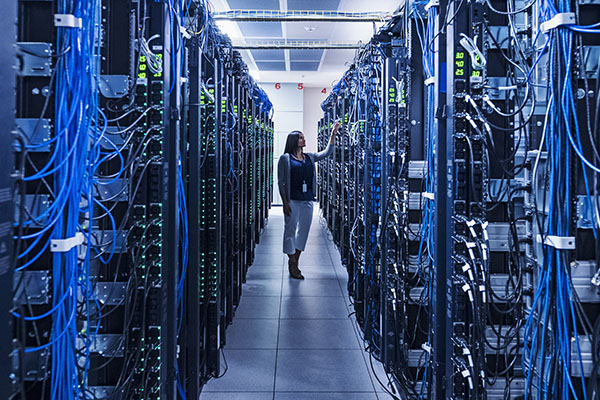IoT in the workplace: Benefits and applications
Internet of Things (IoT) technology has helped transform the workplace into a more efficient, productive, and safer environment. IoT in the workplace is modernizing traditional office spaces with smart technology, enabling for real-time responsiveness to virtually endless tasks and operations.
What is the Internet of Things? IoT is a network of devices, or “things”, that are embedded with sensors that collect data. These sensors communicate with each other through the cloud via internet connectivity, which includes 5G cellular networks, Wi-Fi, and Bluetooth®. That data is collected through cloud-based applications where it’s analyzed in real-time to deliver insights and results to end users.
Since its conception in the early 1980s, IoT technologies have become central to day-to-day life, especially for businesses. IoT is having a revolutionary impact on industrial processes, including assembly line robotics and transportation vehicle predictive maintenance, it helps to cut energy costs, boost security, improve safety, and many other operations. IoT is reshaping how we think about our workplace, including within the office, and what smart technologies can do for us. No matter the industry, integrating IoT into the workplace offers many benefits than businesses are realized in increasingly adopting.
What are the benefits of using IoT in the workplace?
IoT technologies in the workplace come with a host of benefits from saving money to streamlining operations. It’s designed to work in the background by performing complex calculations and processing data to help businesses operate more efficiently and productively.
Automation through IoT
IoT has transformed office operations. Many smart sensors around a workplace can learn from daily patterns and adjust on their own, meaning everything just works without anyone having to think about it.
IoT is used to automate lighting, which helps to reduce energy costs detecting when a room is occupied, as well as adjusting lights to natural light from windows throughout the day. IoT sensors in elevators allow for predictive maintenance to help prevent downtime and improve safety and reliability. HVAC systems use sensors to gauge temperature and cycle times, which not only saves energy but can help extend the life of HVAC systems.
Within employee tasks, IoT can help teams by delivering data and insights that help enable them to make smarter decisions where human intervention is needed, saving time and money.
Productivity through IoT
IoT sensors collect data that can save untold hours of work of manually collecting information. Rather than having to manually compile information from multiple sources, sensors can feed into applications that collect, process, and analyze data for you.
This productivity isn’t only in the office workplace, but in spaces like retail stores. IoT in the retail industry is used in smart shelves, which include weight sensors to detect inventory volumes. Employees can be alerted when an item is low and needs restocking. And radio frequency identification (RFID) tags can also help with inventory management, as well as track assets to know its location in the supply chain before it arrives to the store and in store, help control theft.
IoT can help reduce costs
IoT technology can save businesses money. Ultimately, the efficiencies mentioned not only improve efficiency and productivity, but they can prevent waste and catastrophic breakdowns. IoT sensors collect data to provide a more comprehensive view of your business, enabling for more informed operations, analysis, and planning. These savings add up quickly, making it easier for businesses to cut costs.
IoT helps eliminate time and effort spent on routine tasks to save your workplace time and money. There are many ways to integrate IoT into your business. While it may seem like a big undertaking, it’s not something that can or needs to happen overnight. And many suppliers and providers of applications, services, and other technologies already have IoT integrated into their offerings.
IoT applications in the workplace
Here are some practical ways IoT in the workplace is making a difference right now.
Smart Office equipment
Modern offices are getting smarter with connected devices that talk to each other. Printers can alert an assigned team before they run out of toner, while meeting rooms automatically update their availability status. Smart lighting adjusts based on natural daylight and occupancy for saving energy. These small automations create efficiencies that can save money directly.
Workplace safety
Keeping employees safe has become easier through IoT sensors placed throughout an office or facility. Smart wearables, which can include smartwatch devices and clothing, can detect if someone takes a fall in a manufacturing facility. Job site managers, both in office and in industrial settings, can geofence high-risk areas and use IoT sensors to detect dangers and accidents. Environmental sensors continuously monitor air quality, temperature, and humidity. These devices act like an invisible safety net, alerting facility managers to potential hazards before they become problems. In areas with heavy machinery, IoT sensors can create safety zones and alert workers who might be getting too close to dangerous equipment.
Improved workplace security
IoT-connected workplace security uses a combination of smart technologies to keep buildings secure while making access easier for authorized personnel. Biometric scanners provide touchless entry, while smart cameras can detect unusual activity after hours. These systems learn normal patterns over time, so they can identify when those patterns are broken, potentially detecting security concerns more actively.
Inventory and asset management
Keeping track of office and industrial assets used to mean endless spreadsheets and manual counts. Now, RFID tags and smart sensors do the heavy lifting. Whether it’s tracking expensive equipment or managing office supplies, IoT sensors can provide real-time location visibility. The system can tell you exactly where an item is, and for inventory, automatically place new orders before you run out.
Employee experience
Imagine walking into a workplace that’s automated to align with your needs. Smart desks adjust to your preferred height automatically, lighting shifts to your ideal brightness, and the temperature in your area stays just how you like it. These personalized touches, enabled by IoT in the work environment, might seem small but they create a more comfortable, productive workspace where employees feel valued.
Adding IoT to the workplace is exciting and offers a long list of benefits. However, as with any technology, there are considerations to be aware of in responsibly managing this technology.

Using AI to drive business success
Using AI can be a game changer for scaling your business. Andy Markus, CDO from AT&T Business, discusses using AI for smarter business decisions.
Challenges and concerns with IoT in the workplace
While IoT in your workplace brings countless benefits, it can also introduce security vulnerabilities.
Data privacy and cybersecurity risks
Each IoT device creates an entry point to your network. These vulnerabilities not only might expose the data that’s being collected but also provide an entry point to your business as a whole. The data that’s collected can be very valuable to cybercriminals.
While cybersecurity is a priority for all businesses, integrating IoT means that it’s imperative to have a comprehensive security architecture that covers all endpoints – sensors, mobile devices, and everything that connects to your network.
This security begins with having a reliable, secure network. Next, adding a comprehensive security solution that’s built into your connectivity, like AT&T Dynamic Defense, which blocks 97% of cyber threats1, helps reduce attack risks.
A robust security infrastructure is a must for all businesses. However, because IoT in the workplace introduces entry points into your network, security is a critical step to reducing your risks for your business to be compromised.
The future of IoT in the workplace
IoT is nothing new, however, the rate of IoT adoption is. Other technologies, like 5G and artificial intelligence (AI), are playing a significant role in smart office evolution. Real-time responses are empowering teams to work faster and with more data than ever before. The result is a workplace that can accomplish more, innovate faster, and serve the needs of the business—especially serving and servicing customers—in more effectively than ever before.
How do these technologies work together to make this happen? IoT technology in AI integrates to make sense of IoT data. Rather than just collecting information, AI-powered systems can be trained to make decisions in real-time. Occupational Health and Safety (OHS) reports show, “integrating AI and IoT into workplace safety enhances predictive analytics, real-time monitoring, and proactive risk management to significantly reduce accidents and improve overall safety.” These technologies can not only save your business money but can also increase your workplace safety and help prevent costly accidents, both for employees and the business.
Together, 5G and AI are pushing workplace IoT beyond simple automation. They’re creating offices that don’t just react to what’s happening now but anticipate what’s needed next—like adjusting building systems for tomorrow’s weather forecast or reorganizing meeting spaces based on team collaboration patterns. The future workplace will be more intuitive and responsive than ever.
Learn more about AT&T IoT solutions. To connect with an expert who knows business, contact your AT&T Business representative.
Why AT&T Business
See how ultra-fast, reliable fiber and 5G connectivity protected by built-in security give you a new level of confidence in the possibilities of your network. Let our experts work with you to solve your challenges and accelerate outcomes. Your business deserves the AT&T Business difference—a new standard for networking.
1Based on threats stopped across the AT&T network. AT&T Dynamic Defense Firewall Validation Report by SecurIQlab®, Sept 2024. AT&T Dynamic Defense available with AT&T Dedicated Internet and select customers with Switched Ethernet.




Share
Share this with others